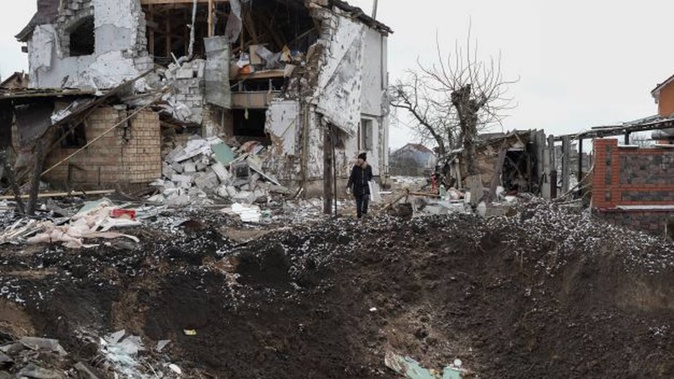
Russian forces fired another rash of missiles and self-exploding drones in nearly a dozen provinces of Ukraine early on Thursday, causing the first attack-related death of the year in Kyiv and killing at least 11 people in all.
The spokesperson for Ukraine’s State Emergency Service, Oleksandr Khorunzhyi, announced the casualty toll in comments to Ukrainian television. He said the attacks also wounded at least 11 people.
The attacks adhered to Russia’s recent pattern of launching widespread strikes about every two weeks.
However, the latest onslaught came a day after Germany and the United States upped the ante in Russia’s 11-month war by promising to send high-tech battle tanks to Ukraine and green-lighting other allies to do the same.
Kyiv Mayor Vitali Klitschko said one person was killed during the attacks, the capital’s first such death since New Year’s Eve. Two others were injured, he said.
The head of the Kyiv city administration, Serhii Popko, said Ukrainian air defences shot down 15 cruise missiles heading to the area.
The regional prosecutor’s office in Ukraine’s Zaporizhzhia province said three people were killed and seven injured in a strike on an energy facility. Valerii Zaluzhnyi, the commander of Ukraine’s armed forces, said Thursday’s volley involved a total of 55 missiles, of which 47 were intercepted.
Self-exploding drones swept in overnight before the missile strikes, in what a spokesperson for Ukraine’s Southern Defense Forces said appeared to be a Russian attempt to overwhelm or distract Ukraine’s air defences. As air raid sirens echoed across the country, civilians, some tugging pet dogs on leashes, poured into subway stations, underground parking lots and basements to seek shelter.
It was the first such barrage of Russian firepower across the country since January 14.
Russia has carried out massive strikes on Ukrainian power plants and other infrastructure since early October, part of a strategy to try to hamper Ukrainian forces and put civilians in the cold and dark this winter, before what many experts predict could be a springtime offensive as more conscripts reach the battlefields.
Ukrainian Energy Minister Herman Halushchenko said energy facilities were again targeted on Thursday by Russian forces who were “trying to cause a systemic failure in the energy system of Ukraine”. He acknowledged some energy facilities had been hit, resulting in emergency outages, and repair teams were working to restore the power supply as quickly as possible.
Maksym Marchenko, the governor of southern Ukraine’s Odesa region, said energy infrastructure facilities were damaged in his and several other regions, causing “significant problems with electricity supply”.
The regional administration in the nearby Kherson region, where Ukrainian troops recaptured the regional capital in November, said Russian shelling had killed two people and wounded five over the past day.
The attacks came a day after Germany said it would supply 14 high-tech Leopard 2 battle tanks to Ukraine and authorise other European countries to send up to 88 more.
The US said it planned to ship 31 Abrams M1 tanks to Ukrainian forces.
German Chancellor Olaf Scholz with German army Bundeswehr soldiers at a "Leopard 2" main battle tank during a training and instruction exercise in Ostenholz, Germany, last year. Germany will send some of the tanks to Ukraine, along with other high-tech tanks to be sent by the US. Photo / AP
Along with Germany and the US, Britain, Poland, the Netherlands and Sweden are among the nations that have sent or announced plans to supply hundreds of tanks and heavy armoured vehicles to fortify Ukraine as it enters a new phase of the war and tries to break through entrenched Russian lines.
The conflict has largely been a stalemate in recent months, though Ukrainian forces acknowledged on Wednesday a controlled pullout from the salt-mining town of Soledar in Donetsk province, a battle-scarred area of eastern Ukraine that has been embroiled in war since Russia-backed separatists seized large swaths of the broader Donbas region in 2014.
Gian Gentile, a US Army veteran and senior historian with the Rand think tank, said the M1 Abrams and the Leopards would give Ukraine a “mechanised armoured punching force”.
German Defence Minister Boris Pistorius said Ukrainian crews will start their training in Germany in coming days on German-made Marders, which are infantry fighting vehicles, while training on the heavier Leopard 2 tanks would start “a little later”.
“In any case, the aim with the Leopards is to have the first company in Ukraine by the end of March, beginning of April,” he added. “I can’t say the precise day.”
In an interview with Britain’s Sky News on Wednesday, Ukrainian President Volodymyr Zelenskyy said he didn’t know when the tanks from the US and Europe would arrive.
Nato Secretary-General Jens Stoltenberg, also speaking to the British network, declined to speculate on the timing, but said “allies are extremely focused on the importance of speed.”
Kremlin spokesman Dmitry Peskov said the move to provide Ukraine with modern Western tanks reflected the West’s growing involvement in the conflict.
“Both European capitals and Washington keep saying that the delivery of various kinds of weapons systems, including tanks, to Ukraine, absolutely does not mean the involvement of these countries or the alliance in the hostilities ongoing in Ukraine,” Peskov told reporters. “We categorically disagree with that.”
“Moscow views everything that has been done by the alliance and the capitals I have mentioned as direct involvement in the conflict,” he added. “We can see it growing.”
- Hanna Arhirova, AP
Take your Radio, Podcasts and Music with you

/cloudfront-ap-southeast-2.images.arcpublishing.com/nzme/3KWARWKF6FF6JLNJFK2LTZS2NI.JPG)







